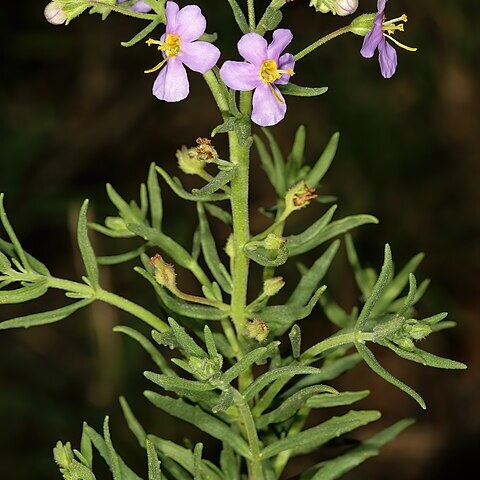An erect herb, often annual, but capable of perennating, the taproot eventually woody and up to c. 8 mm in diam. at the crown, main stem erect to c. 70-450 mm, branching from the base, branches erect or decumbent, simple or branching from the base or higher into a corymbose panicle, glandular-pubescent, hairs up to 0.2-0.25 mm long, glistening glands as well, densely leafy, with axillary leaf-tufts. Leaves opposite, bases connate, primary leaves up to 17-30(-45) x 2-8(-15) mm, smaller upwards (axillary leaves also smaller) and passing into bracts, oblong to elliptic, apex ± acute, base somewhat narrowed to distinctly petiolar, margins subentire or with up to 6 pairs of small teeth, hairy as the stems. Flowers in long terminal racemes eventually forming corymbose panicles, sometimes well-branched. Bracts (lowermost) leaflike, c. 7-15 x 1.2-5 mm, more than twice as long as broad. Pedicels (lowermost) 10-30 mm long. Calyx obscurely bilabiate, tube 1-1.8 mm long, lobes 1.8-3.1 x 0.8-1 mm, lanceolate, densely glandular-pubescent, hairs up to 0.25-0.5 mm long. Corolla tube 3-4.5 x 2.5-4.5 mm in throat, broadly funnel-shaped, limb almost regular, c. 8.5-14 mm across, posticous lobes 3-5 x 2.5-4 mm, anticous lobe 3-5 x 2.5-4 mm, all suborbicular, shades of pink, mauve or blue-violet, tube yellow/orange, glandular-pubescent outside, hairs up to c. 0.25 mm long, glistening glands as well, clavate hairs inside all round throat. Stamens 4, all exserted, anthers 1.3-2 mm long, posticous filaments 1.5-2.2 mm long, anticous filaments 2.5-4 mm. Stigma 2-3.5 mm long, exserted. Style 1.5-3.5 mm long, clad in glistening glands, occasionally minute glandular hairs as well. Ovary 1.3-2 x 1-1.5 mm, with glistening glands at apex and down sutures. Capsules 3-5 x 2.5-3.5 mm, glistening glands persisting. Seeds c. 0.5 x 0.3 mm, pallid. Flowering occurs between November and May, peaking in February.
More
Annual herb, up to 0.45 m high; with simple taproot. Stems erect, much branched, glandular-pubescent. Leaves fascicled in axils; blade oblong to elliptic, up to 30 x 8 mm, apex ± acute, base connately narrowed to distinctly petiolate, margins dentate, sometimes with small teeth, hairy. Flowers: solitary, ultimately innumerable, in leaf axils, loosely in corymbose panicles 8-14 mm in diameter, passing into bracteate racemes; stamens 4, exserted; corolla with tube yellow to orange, 3.0-4.5 mm long, limb spreading, 6-8 mm in diameter, lobes white, pink to mauve; Nov.-May., mostly in Feb.
Annual or perennial, branched herb with most parts glandular-pubescent. Stems up to 450 mm high, densely leafy and with leaf tufts in axils. Leaves opposite, oblong to elliptic, ± acute, margins sometimes with small teeth. Flowers in corymbose panicles formed of long, terminal racemes. Corolla: tube short, 3.0-4.5 mm long, wide, yellow or orange; lobes pink or mauve to blue-violet. Flowering time Nov.-May, mostly in Feb.
Erect herb, often annual, but capable of perennating. Taproot simple, eventually woody. Leaves oblong to elliptic, primary leaves up to 17-30(-45) x 2-8(-15) mm, diminishing in size upwards. Inflorescence with flowers in long terminal racemes, eventually forming corymbose panicles, sometimes well-branched. Flowers with corolla lobes shades of pink, mauve or blue-violet, tube yellow/orange.

